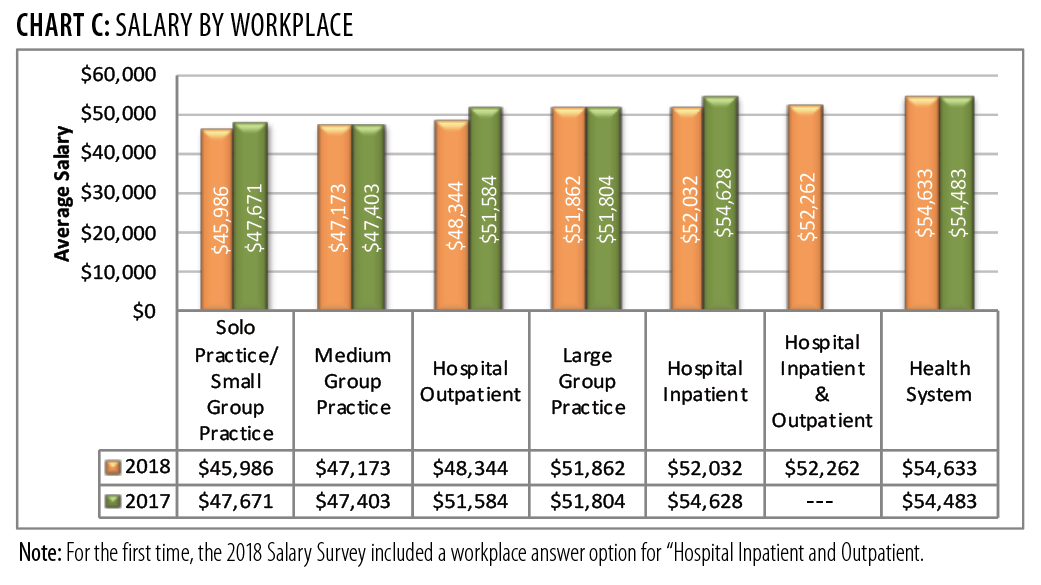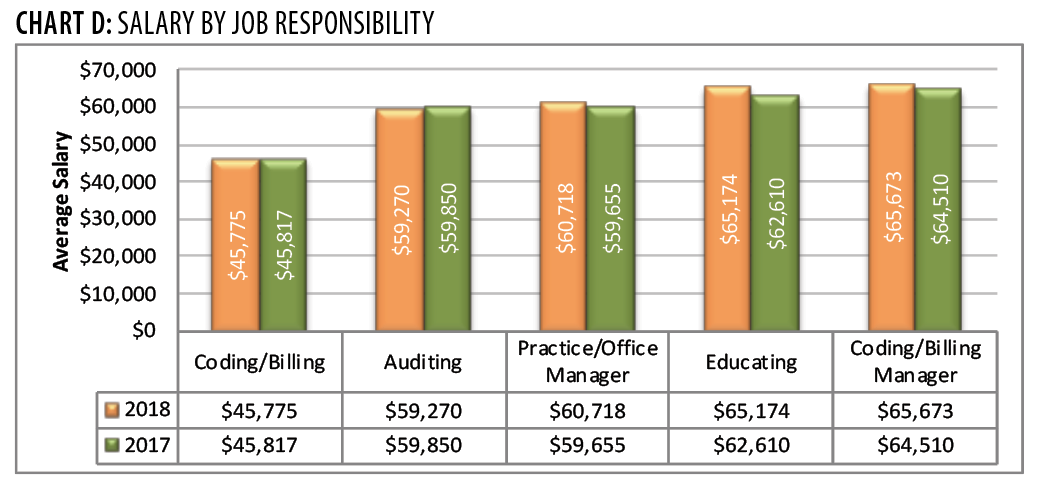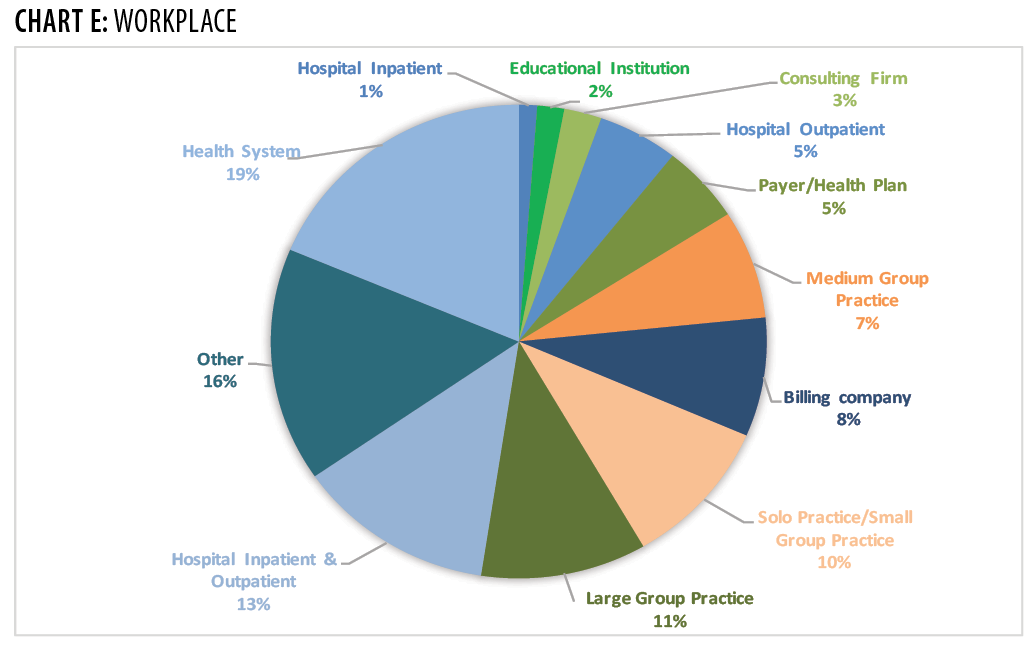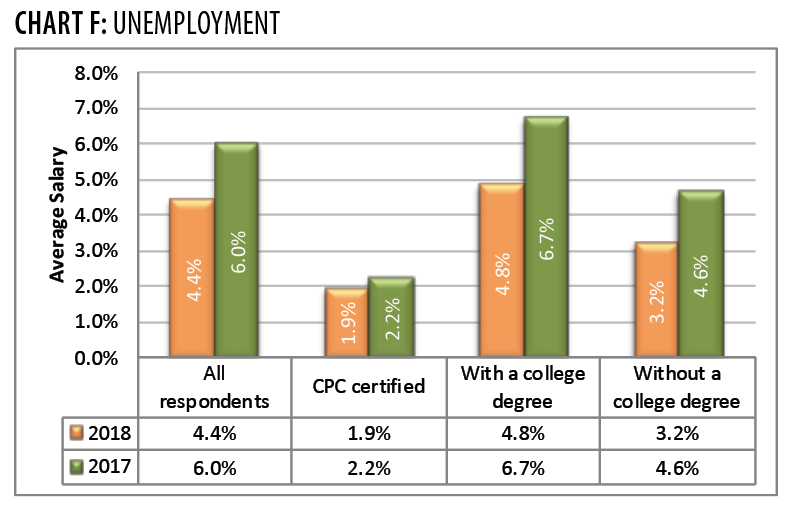2018 Salary Survey: Credentials Serve Our Members Well
- By Dave Blackmer, MSC
- In AAPC News
- February 1, 2019
- 10 Comments

Data shows the time to get certified is now.
AAPC’s Salary Survey results this year show the overall average salary for healthcare business professionals is $51,889, while the average credentialed member makes about $54,500. Specifically, those who hold a Certified Professional Coder (CPC®) credential average $54,401 (up nearly 9 percent from last year), and those who hold any AAPC credential average $54,506 (about half a percent more than last year). Comparing the average salaries based on years of experience, it would take 20 years for an uncertified individual to make the same salary as someone with a single AAPC credential.
We admire those who are so dedicated to this industry that they remain in healthcare for decades. If you want to move your career forward faster, we strongly encourage certification. As a frame of reference, Chart A shows the average salaries of those who hold no certifications but have varying years of experience.

Salary by Credential
We saw a slight drop in the average salaries for certified instructors and those holding the Certified Outpatient Coder (COC™) or Certified Risk Adjustment Coder (CRC™) credential, but all other current certifications increased this year, as illustrated in Chart B. The largest increase is seen by Certified Inpatient Coders (CICs™), who report an average income of $56,045. Billing Specialist career paths are quite lucrative, and billing specialists entering the field can expect to move onto senior positions in less than 10 years in most cases.

Factor in Where You Work
Average salaries by workplace or job responsibility did not fluctuate very much when compared to last year, as shown in Chart C. Average hospital salaries saw the largest drop, but were primed for this decrease, considering the 2017 hike of nearly 10 percent. Despite the AAPC Certified Instructor (CPC-I™) data indicated in Chart B, those in education still seem to be doing very well. Even though there may be some discrepancy between the salary data for CPC-Is™ and those who classify their job responsibilities as educational, the resulting average salaries for this group are still among the highest in each respective framework.

Production Standards, Accuracy, and Pay Rates
Although the majority of our respondents are not held to production or accuracy standards, those who are make up a sizable amount of the industry. Tables A, B, and C represent the baseline of required standards from employers who have such stipulations in place.
Table A:
Production Standards: Inpatient
| Less than 5 | 6.4% |
| 5 to 10 | 10.6% |
| 11 to 15 | 13.3% |
| 16 to 20 | 10.8% |
| 21 to 25 | 7.6% |
| 26 to 30 | 4.4% |
| More than 30 | 22.8% |
Table B:
Production Standards: Outpatient and Professional Services
| Outpatient | Professional Services | |
| Less than 25 | 12.0% | 12.5% |
| 25 to 50 | 22.5% | 19.7% |
| 51 to 75 | 14.0% | 12.5% |
| 76 to 100 | 17.6% | 16.8% |
| 101 to 125 | 9.0% | 8.3% |
| 126 to 150 | 6.3% | 5.7% |
| More than 150 | 9.8% | 10.4% |
Table C:
Internal Audit Accuracy Standards
| Less than 80% | 1.0% |
| 80% – 85% | 3.7% |
| 86% – 90% | 4.7% |
| 91% – 95% | 19.7% |
| 96% – 98% | 22.0% |
| More than 98% | 6.4% |
By comparing the average salaries of employees who face varying standards of production and accuracy, we found a disappointing trend. Those who are held to a higher standard consistently make less money. Our best hypothesis is that key decision-makers who understand the value of high standards also keep a close eye on employee compensation, perhaps treating the latter more strictly than they ought to. Just as our healthcare system is rewarding quality of care, we encourage employers to recognize and reward the best quality work on our side of the industry.
Table D:
Salary by Employer-required Standard
| Accuracy | Production-Inpatient | Production-Outpatient | Production-Pro Fee | |
| Highest level | $47,553 | $46,843 | $43,718 | $46,677 |
| Lowest level | $49,837 | $52,804 | $52,097 | $54,093 |
Undeniable Advantages in
Salaried and Remote Employment
Different aspects of each position are perks for some, drawbacks for others. The average amount of money earned cannot be denied, however. Those who work for hourly wages make an average of $46,601 a year, whereas those who are salaried earn $63,079 on average. Employees who worked an even 40 hours per week averaged a salary of $48,878, while those who put in 50 or more hours brought in an average of $67,135.
Onsite employees make an average of $50,647 annually, and their remote counterparts earn an average of $54,296. Remote employees tend to have more credentials, however. In terms of holding two or more certifications, roughly 40 percent of remote employees met this criterion, compared to only about 30 percent for onsite employees.
A Word to Employers About Employee Burnout
At the end of 2018, the national unemployment rate was lower than it has been in almost half a century, according to the U.S. Bureau of Labor Statistics. In this field, unemployment rates have dropped significantly when compared with last year, as shown in Chart F. There are more open jobs than unemployed individuals, so those in the workforce have a surprising advantage: If they don’t like a job situation, it’s easier than ever to find something else.



Consider the following data points to help you retain your best people:
Those who indicated they were looking for a different job because they wanted more money made an average of $40,753.
Respondents who marked they were “very dissatisfied” with their jobs made an average of $46,726, but clearly it wasn’t just an issue of how much money they brought home. If they noted they were looking for another job, the No. 1 reason they gave was simply because they don’t enjoy the work environment. These very dissatisfied respondents tended to have higher production standards than those given by rest of the respondents. Compare Tables E and F to Tables A and B.
Table E:
Dissatisfied Production Standards: Inpatient
| Less than 5 | 2.9% |
| 5 to 10 | 8.8% |
| 11 to 15 | 5.9% |
| 16 to 20 | 10.3% |
| 21 to 25 | 13.2% |
| 26 to 30 | 7.4% |
| More than 30 | 32.4% |
Table F:
Dissatisfied Production Standards: Outpatient and Professional Services
| Outpatient | Professional Services | |
| Less than 25 | 12.0% | 10.0% |
| 25 to 50 | 23.3% | 24.0% |
| 51 to 75 | 10.5% | 13.0% |
| 76 to 100 | 13.5% | 9.0% |
| 101 to 125 | 9.8% | 8.0% |
| 126 to 150 | 8.3% | 6.0% |
| More than 150 | 17.3% | 18.0% |
This same group of very dissatisfied individuals indicated their employers placed roughly the same amount of emphasis on accuracy. Compare Table G to Table C. In other words, some workplaces cause incredible frustration when they demand increased quantity without sacrificing quality. These expectations will inevitably lead to employee burnout, not to mention costly errors.
Table G:
Dissatisfied Internal Audits
| Less than 80% | 1.2% |
| 80% – 85% | 2.8% |
| 86% – 90% | 4.7% |
| 91% – 95% | 18.9% |
| 96% – 98% | 20.3% |
| More than 98% | 6.6% |
Making a Living Where You Are

There was little variance in the salary averages by region as compared to last year. These numbers are to be expected, though, as the unemployment rate drop can most easily be explained by more people filling new positions — most likely jobs at entry-level wages.
Resources
U.S. Bureau of Labor Statistics: https://data.bls.gov/pdq/SurveyOutputServlet
U.S. Bureau of Labor Statistics, Economic News Release, Job Openings and Labor Turnover Summary: www.bls.gov/news.release/jolts.nr0.htm
Department on Numbers, U.S. Unemployment: www.deptofnumbers.com/unemployment/us/
- Medical Coding and Billing Salary Survey 2019 - January 29, 2020
- Justify Your Job Expenses - March 7, 2019
- Know 2018 Salaries with New Calculator - February 19, 2019





Hi David,
Wondering if I could reach out to you via email and have you run some salary numbers for me in my area?
Thanks!
David, I also have a great question and would like to know if I can send by email. Thank you.
At our Practice we have six physicians. My physicians perform their own coding and complete the invoice for the E/M visit along with any procedures performed for download to billing. At this point, I have a staff member with over 15 years experience who reviews the charges and coding. She occasionally needs to adjust order of ICD codes to reflect the one for the actual visit is listed first and continuing medical issues are after. She enters modifiers where needed and then claims are sent out. She has taken the CPC coding class but did not pass. We paid for her class. We paid for the certification test and offered to pay for her to retake the test. She made the decision not to pursue. She is paid above the salary survey results for having no certification. She has approached me regarding a salary increase because she does the work of a coder. I am not inclined to pay for certification that she does not have. She does not do chart audits or help the physicians with coding issues. I have a consultant ( with multiple certifications) that I use on a prn basis to do chart audits and work with new hires to bring them up to speed with CPT and ICD-10 coding. How do other offices handle salary in a situation such as this?
I would have a meeting with her to outline and go over her duties and take it from there. If she is already making above the salary survey results you are not inclined to increase her pay. Unless, her duties change significantly and she adds on a certification (s) , her current salary is sufficient. I would politely let her know she does not qualify for an increase at the moment.
Angela, You are not obligated to increase staff pay rates based on request. We have a set range of hourly rates based on position. If a person reaches the top of the pay range for the duties they perform, we give them an annual bonus if they have consistently “exceeded expectations” during the year. The bonus is not automatic and they realize that. It provides the option to pay some extra, without an obligation for an unending increase on top of an increase. I had similar situation where staff failed the coding exam and decided not to retake…it is discouraging to make that kind of investment into staff and have it not pay off for the individual or for the company. I would explain that she has topped out in the salary range for her duties. It won’t be an easy discussion to let her know that her “coding” duties are actually “billing” duties, I expect experienced billers to do the same duties you described above and they consistently do it well! People who want to increase their position in life need to invest in themselves…doesn’t sound like she is prepared to do that at this time. Maybe once she understands that she has hit a limit, she will be willing to work towards the next accomplishment. You could also lose her to another employer…
Hello,
i am considering training for Medical Coding or Billing. However, i am not sure which path i want to take whether i want the Coding or Billing. I have been looking at online schools but I’ve heard that employers look for AAPC accred. I have very little experience with medical coding, however, i have experience in the healthcare field (Insurance call center, Credentialing, Dental). I had a baby and had to resign my credentialing position and i was wanting to keep my skills of working; and work from home. i was advised to look into the medical coding/billing world. Can someone help me with how to go on about this?
Thank you!
Daisy I did consider online if you trust yourself. I like the classroom, interaction with teacher and students help me when I am stuck. But if you can do the online it’s a good choice.
I also am considering doing. Medical coding or billing.. First I need to know the difference between the two. And secondly, can you do this type of work from home? And thirdly what schools are the best schools in New York? I am retired and I would just like to do something else…
What is the pass/fail rate of this program for the credentialing tests?
Also, I am an RN with 27 years nursing experience in a variety of settings. Is there any benefit to me for that, in terms of having some working understanding of what the charts say and what is appropriate based on documentation? I’m kinda burnt out on nursing and this is an avenue I’ve considered taking. I’d be delighted to be at home and out of the ongoing drama filled work world.
I am curious of AAPC’s actions to support the training for Billing and Coding outside of the US. As many For-Profit companies are being contracted by major Healthcare systems and then eliminating US positions to outsource to countries like India.